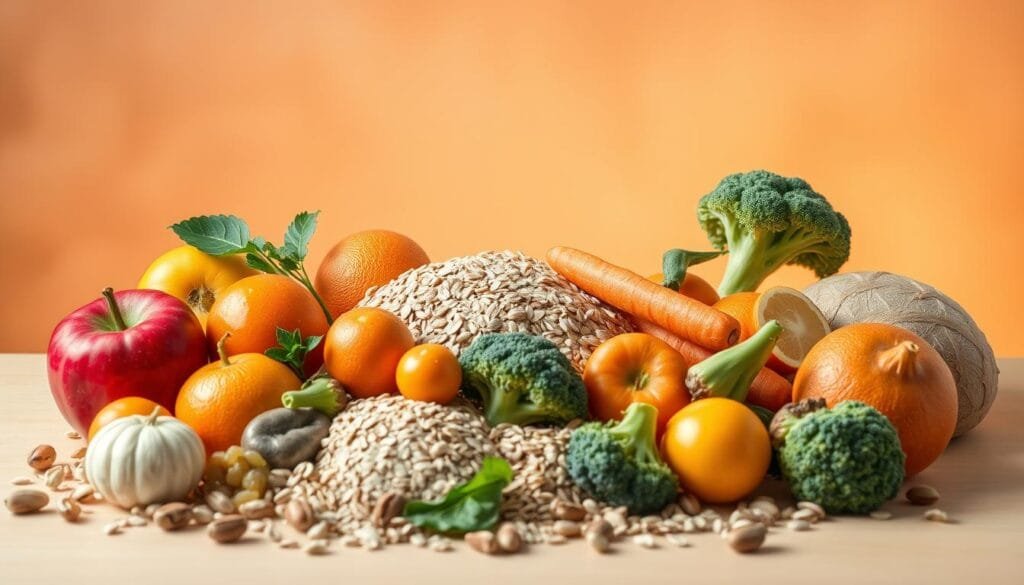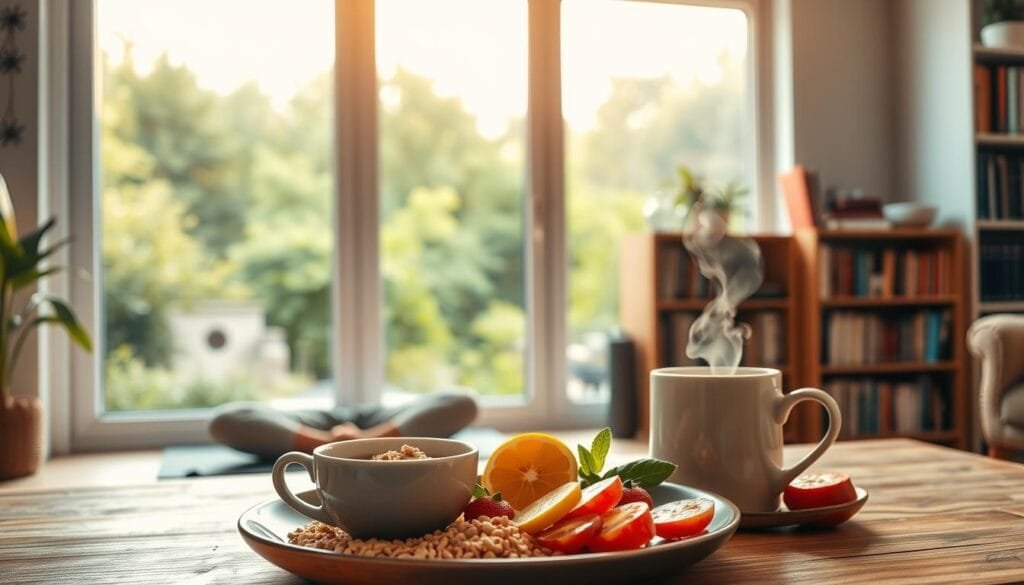Currently Empty: RM0.00
Ever feel like a heavy meal drains your energy instead of fueling you? That post-lunch crash is more than just fatigue—it’s your body working hard to digest food. Wellness Concept explains how simple dietary tweaks can keep energy levels steady.
Digestion turns meals into glucose, the body’s main energy source. Hormones like CCK and amylin control fullness, while serotonin from tryptophan-rich foods impacts mood. Balancing these factors helps avoid that sluggish feeling.
Wellness Concept combines science-backed food choices and lifestyle habits. Their experts recommend nutrient-rich meals to sustain energy without crashes. For personalized advice, message them on WhatsApp at +60123822655.
Key Takeaways
- Post-meal fatigue stems from digestion and hormone activity.
- Balanced meals support steady energy levels.
- Wellness Concept offers tailored diet solutions.
- Fiber-rich foods help stabilize blood sugar.
- Immediate guidance is available via WhatsApp.
Why Do You Feel Tired After Eating?
Why does a satisfying meal sometimes leave you ready for a nap? The answer lies in how your body processes food. Digestion shifts energy away from other functions, and certain ingredients amplify this effect.
The Science Behind Post-Meal Sluggishness
After eating, insulin helps move glucose into cells for energy. Simple carbohydrates spike blood sugar levels, leading to crashes later. This rollercoaster drains energy.
Tryptophan, an amino acid in foods like cheese and eggs, converts to serotonin. While serotonin boosts mood, it also promotes relaxation. A 2023 study linked high-tryptophan meals to stronger postprandial somnolence.
Common Culprits: Foods That Cause Fatigue
Not all meals weigh you down equally. Here’s what to watch for:
| Fatigue-Triggering Foods | Energy-Sustaining Alternatives |
|---|---|
| White bread, pastries (simple carbs) | Quinoa, oats (complex carbs) |
| Sugary desserts | Dark chocolate (70%+ cocoa) |
| Alcohol | Herbal tea, water |
| Fried foods | Grilled lean proteins |
Pairing carbohydrates with protein or fiber slows digestion, stabilizing blood sugar levels. For example, swap a muffin for yogurt with berries to avoid postprandial somnolence.
How Fiber Can Help Combat Post-Meal Sluggishness
Nutritional choices directly impact how you feel after eating—here’s how to optimize them. Incorporating the right nutrients, like fiber, can transform your energy levels and keep fatigue at bay.

The Role of Fiber in Digestion and Energy
Fiber slows carbohydrate absorption, preventing blood sugar spikes. Soluble fiber forms a gel-like substance in the gut, while insoluble fiber adds bulk. Both types support healthy digestion and steady energy release.
A 2023 study linked Mediterranean diets—rich in whole grains and legumes—to reduced post-meal fatigue. The WHO recommends 25g of fiber daily for optimal health.
Best High-Fiber Foods to Include in Your Diet
Malaysia offers plenty of local, fiber-packed options:
- Okra: 3g fiber per cup (soluble and insoluble).
- Guava: 9g per fruit, plus vitamin C.
- Oats: 4g per serving, ideal for breakfast.
For sustained energy, pair these with lean proteins like grilled fish or tofu. A sample day:
- Breakfast: Oatmeal with chia seeds.
- Lunch: Brown rice with stir-fried okra.
- Dinner: Guava salad with grilled chicken.
Gradually increase fiber intake to avoid bloating. Your gut microbiome thrives on diversity, boosting metabolism and energy levels over time.
Dietary Tips to Avoid the Afternoon Slump
Struggling with afternoon fatigue? Your lunch choices might be the culprit. Small tweaks to meals can prevent energy crashes and keep productivity high.
Balanced Meals for Sustained Energy
Research shows eating six small meals daily beats three large ones for steady blood sugar. Try the “energy plate” formula:
- 50% veggies: Spinach, cucumber, or Malaysian kangkung.
- 25% protein: Grilled chicken, tofu, or ikan bakar.
- 25% complex carbohydrates: Brown rice or quinoa.
For lunch, try a nasi kerabu bowl with extra greens and grilled fish. The slow-digesting carbohydrates prevent spikes in sugar levels.
Foods to Avoid for Better Alertness
Skip these energy killers:
| Alertness Drainers | Smart Swaps |
|---|---|
| White rice (nasi putih) | Red rice or barley |
| Bubble tea | Iced lemongrass tea |
| Fried karipap | Roasted chickpeas |
Hydration matters too. Often, thirst mimics hunger. Drink water before reaching for snacks. Aim for meals every 3 hours to stabilize blood sugar.
Lifestyle Changes to Boost Energy Levels
Small daily habits can dramatically improve how you feel after meals. Beyond food choices, hydration, movement, and rest play pivotal roles in sustaining energy throughout the day.

The Importance of Hydration and Exercise
Dehydration mimics fatigue, slowing digestion and cognitive function. A simple formula: drink 35ml of water per kilogram of body weight daily. For a 60kg person, that’s 2.1 liters.
Exercise doesn’t require a gym. A 15-minute post-lunch walk cuts fatigue by 30%, per a 2023 study. Try these 5-minute office routines:
- Chair squats (strengthens legs)
- Desk stretches (reduces stiffness)
- Standing calf raises (boosts circulation)
Sleep and Its Impact on Post-Meal Fatigue
Poor sleep disrupts circadian rhythms, worsening post-meal sluggishness. The Sleep Foundation links 7+ hours of rest to stable blood sugar levels. Compare the effects:
| 6 Hours of Sleep | 7+ Hours of Sleep |
|---|---|
| Higher cortisol spikes | Balanced hormone production |
| Slower metabolism | Efficient nutrient processing |
For a midday reboot, a *caffeine nap* (coffee + 20-minute rest) enhances alertness. Limit blue light exposure at night to protect melatonin production.
About Wellness Concept
Wellness Concept transforms how people approach nutrition and energy management. Their team blends science with personalized care to tackle fatigue, digestive issues, and metabolic imbalances. Whether you’re managing chronic conditions or optimizing daily health, their methods deliver measurable results.
Our Approach to Health and Wellness
Every plan starts with a 60-minute consultation. Experts analyze:
- Dietary habits: Spot energy-draining patterns.
- Lab results: Food intolerance tests and metabolic panels.
- Lifestyle factors: Sleep, stress, and activity levels.
For food allergies, they use IgG testing to pinpoint triggers. A client reduced midday crashes by 80% after cutting hidden sensitivities like gluten and dairy. “I finally understand my body,” they shared.
Business Hours and Contact Information
Wellness Concept fits busy schedules with extended hours:
- Weekdays: 9:30 AM–6:30 PM (Mon–Fri).
- Weekends: 10 AM–5 PM (Sat–Sun).
Located near KL Sentral with easy MRT access. Message +60123822655 on WhatsApp for same-day replies. Discover more about the health benefits of fiber in their blog.
Conclusion
Energy crashes after eating don’t have to be your normal. By balancing meal timing, staying hydrated, and choosing nutrient-dense foods, you can stabilize energy levels naturally. Track patterns with a food diary—Wellness Concept offers free templates to start.
Persistent fatigue? Don’t ignore it. The Mayo Clinic links chronic feel tired eating episodes to underlying issues. A doctor or nutritionist can help pinpoint causes.
For personalized advice, Wellness Concept provides same-day consultations. Message +60123822655 on WhatsApp to transform how your body processes food. Small steps today fuel brighter tomorrows.
FAQ
Why do some people feel tired after eating?
This is often due to postprandial somnolence, commonly called a “food coma.” When eating, blood sugar levels rise, and the body releases insulin, which can cause drowsiness. Certain foods, like those high in sugar or refined carbs, can make this effect worse.
How does fiber help prevent post-meal sluggishness?
Fiber slows digestion, helping to stabilize blood sugar levels. This prevents sudden spikes and crashes that lead to fatigue. High-fiber foods like vegetables, whole grains, and legumes provide steady energy without the crash.
What are the best high-fiber foods to include in meals?
Some great options are lentils, quinoa, broccoli, chia seeds, and berries. These foods support digestion and help maintain stable energy levels throughout the day.
Are there foods that worsen post-meal fatigue?
Yes. Processed carbs, sugary snacks, and heavy, greasy meals can cause a quick rise and fall in blood sugar, leading to tiredness. Large portions can also make digestion harder, increasing sluggishness.
Can hydration and exercise help with energy levels after eating?
Absolutely. Drinking enough water prevents dehydration, which can worsen fatigue. Light movement, like a short walk after meals, improves circulation and digestion, helping you stay alert.
How does sleep quality affect post-meal drowsiness?
Poor sleep can make fatigue worse after eating. A well-rested body processes food more efficiently, reducing the chances of an energy slump. Aim for 7-9 hours of quality sleep nightly.
Should I see a doctor if I always feel tired after meals?
If fatigue is severe or persistent, consult a healthcare professional. It could indicate underlying conditions like diabetes, food allergies, or thyroid issues that need attention.



